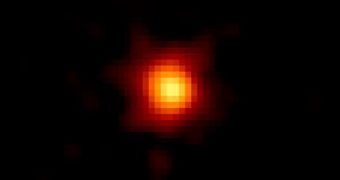Recently, astronomers were surprised to detect a blast of highly-energetic light, originating in a peculiar portion of the Universe. After initial analysis, experts concluded that the explosion may have been produced by the most distant object ever detected in the Cosmos.
The impressive gamma-ray burst (GRB) was short, but extremely bright, and it is now believed to have originated from an object that existed back when the Universe was only a fraction of its current age.
The reason why experts now believe they are dealing with the farthest object seen ever is that measurements indicate the GRB source to be 13.14 billion light-years away. Considering that the Universe is 13.75 billion years old, this is an impressive finding.
Astronomers who made the finding admit, however, that there is a certain degree of uncertainty as far as this distance is concerned. At such huge distance, making accurate calculations is extremely difficult.
Still, if their measurements are valid, then this means that GRB source lived when the Cosmos was only 520 million years old. Also worthy of mention here is that the flash of radiation was most probably released by a dying star.
Supernova are some of the cosmic events in which gamma-ray bursts originate, astrophysicists now believed. These phenomena take place when massive stars reach the end of their burning cycle, and explode violently, while their cores collapse into black holes or neutron stars.
At the same time, while massive stars don't live for a long time, they do take a few million years to reach the end of their burning cycle, by exhausting their hydrogen supplies for thermonuclear fusion.
The light flash this particular star emitted lasted for only 10 seconds, as seen by current detectors, but it shone with the intensity of a million Suns, expert say. This is the equivalent of the light usually emitted by thousands of galaxies, Space reports.
“By looking very far away, because the light takes so long on its journey to reach the Earth, astronomers are effectively able to look back in time to this early era,” Andrew Levan explains .
“Unfortunately, the immense distances involved make this very challenging,” explains the study team member, who holds an appointment as an astronomer at the University of Warwick in England.
The NASA Swift satellite observed this extremely bright GRB back in April 2009, and so the event got the name GRB 090429B. According to experts, the afterglow the explosion left behind lingered in the night sky for several days, allowing more follow-up research to be conducted.
“If I were in Vegas, I would never bet against the odds that this is the most distant GRB ever seen, and we estimate that there is even a 23 percent chance that it is the most distant object ever observed in the Universe,” Antonino Cucchiara explains in a statement.
The expert, a former Pennsylvania State University graduate student who is now at the University of California in Berkeley (UCB), was the leader of the new study. Details of the work were presented at the 218th meeting of the American Astronomical Society (AAS 2011), in Boston.

 14 DAY TRIAL //
14 DAY TRIAL //